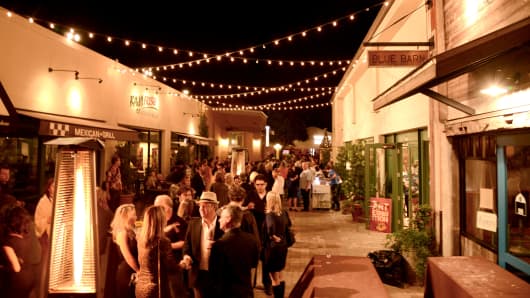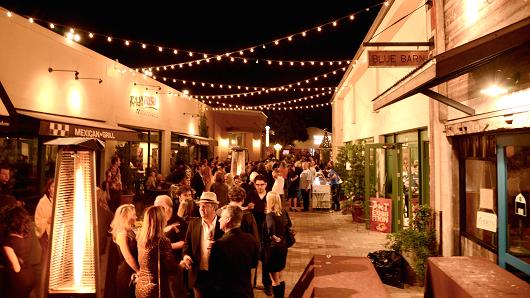
When a 4,000-square-foot space opened up at Town Center Corte Madera, an open-air shopping center near San Francisco, Colliers International had a choice. The brokerage firm could seek out another large tenant to fill the space, or divide it into two less-expensive locations that would be friendlier to small businesses.
After parsing through sales data and noticing a spurt in small-business revenue, Colliers opted to split the space in two, leasing out one half to a local salad and sandwich joint. Since opening at the center in 2013, that San Francisco-based restaurant’s sales per square foot have increased 5 percent annually, to $1,800 a square foot.
“They’re performing far stronger than a restaurant tenant that we have there in 5,000 square feet that’s national,” said Anjee Solanki, national director of USA retail services at Colliers.
The Corte Madera property is not alone. With sales growth at small-business retailers outpacing that of their larger competitors nearly every month over the past four years, landlords are looking more favorably at mom-and-pop tenants than in the past.
But the benefits go beyond a potential sales lift. As shopping centers seek to differentiate themselves from neighboring properties — and drum up traffic in an increasingly digital world — adding small businesses to the mix is an easy way for property owners to accomplish both goals.
Kimco, the largest publicly traded owner and operator of open-air shopping centers in North America, has expanded a program that offers small businesses one year of free rent and reduced property charges. Originally started in California four years ago, it has since been expanded to 19 states.
Malls have traditionally skewed toward credit tenants that have been rated by an outside agency, and are more likely to have the financial strength to pay rent in tough times. Increasingly, however, they are finding ways to make space available for small players. CBL & Associates Properties, which owns both enclosed malls and open-air centers across the U.S., offers a short-term lease program for small businesses.
This initiative provides entrepreneurs the opportunity to grow their businesses, while helping CBL quickly backfill vacancies as it searches for permanent tenants. Though this program is not new for CBL, the company has recently sought out more experience-based tenants at its properties, as Americans continue to favor spending on activities versus goods. One such example is indoor bubble soccer operator “Knockerball,” which has a 12-month lease at its Chesterfield Mall, in Missouri.
“They’re (shoppers) not going to find that tenant anywhere else, and that’s ultimately what you’re looking for,” Jesse Tron, an industry expert formerly with the International Council of Shopping Centers trade group, said of the trend.
Consumers are responding to the unique merchandise, easy-to-shop formats and personal service that come with mom-and-pop retail stores. According to data from MasterCard Advisors, small-business retail sales excluding automobiles and gasoline have risen 5.4 percent so far this year. That compares to 4 percent growth in total retail sales over that same time.
Small apparel retailers and local restaurants are driving much of the trend, Sarah Quinlan, senior vice president of market insights at MasterCard Advisors, told CNBC. Over the past 12 months, retail sales at smaller apparel stores have grown by more than 8 percent, MasterCard found; meanwhile, sales at large apparel stores have declined. As a result, small businesses’ share of the apparel market has increased 2 points from a year ago, to 39 percent.
Small restaurants have also seen a boost. Food service accounted for 32 percent of small-business sales in May, compared to less than 24 percent before the latest recession, MasterCard said.
Though trends have slowed in recent months, with small businesses in April ending a 50-month streak of outperforming their larger competitors, MasterCard notes that summer months typically see a higher share of small-business sales, as travelers seek out unique eateries and stores.
Quinlan added that while small businesses may not continue to see as robust growth, the trend of consumers valuing the unique experience that accompanies shopping there will continue.
“I think we’ve permanently shifted to really wanting to value what we purchase,” she said.
Tom McGee, CEO of ICSC, said that when people think of shopping centers, they tend to remember just the large national brands. However, small businesses occupy as much as 50 percent of all commercial space, according to the latest data from the U.S. Small Business Administration.
A separate report from ICSC says that 85 percent of U.S. shopping centers are neighborhood and community centers, almost half of which are occupied by locally owned businesses. ICSC credits these types of businesses as contributors to the industry’s solid occupancy rates, which ticked slightly higher to 93.5 percent in the first quarter.
“Those small businesses grow into really big businesses,” McGee said. “It’s a really important part of the industry.”
Colliers’ Solanki said it’s now a “requirement” for developers to include small-business tenants in their properties; however, she said they should be balanced out with credit tenants. And while Tron said small tenants are likely a better fit in middle-market regional malls, where space is less costly, the narrative could work at any mall, lifestyle center or urban property, “as long as the landlord understands the risk on both sides and is open-minded,” Solanki said.
While sophisticated shopping center operators have long been familiar with the benefits of incorporating local businesses into their properties, institutional clients are likewise starting to catch on, she said.
“You kind of have to go through that education,” she said. “If you show that you can subsidize some of that risk [with credit tenants] they’re more open to evaluating it.”
For ICSC’s McGee, incorporating small businesses boils down to one simple principle: At its core, they’re what the shopping center industry is all about.
“It operates in a local community. It’s an integral piece of that local city or town. A lot of the tenants in there are folks that live in those towns,” he said. “It’s part of the value proposition of the industry,” he added, saying the level of brand loyalty small stores generate “cannot be understated.”




